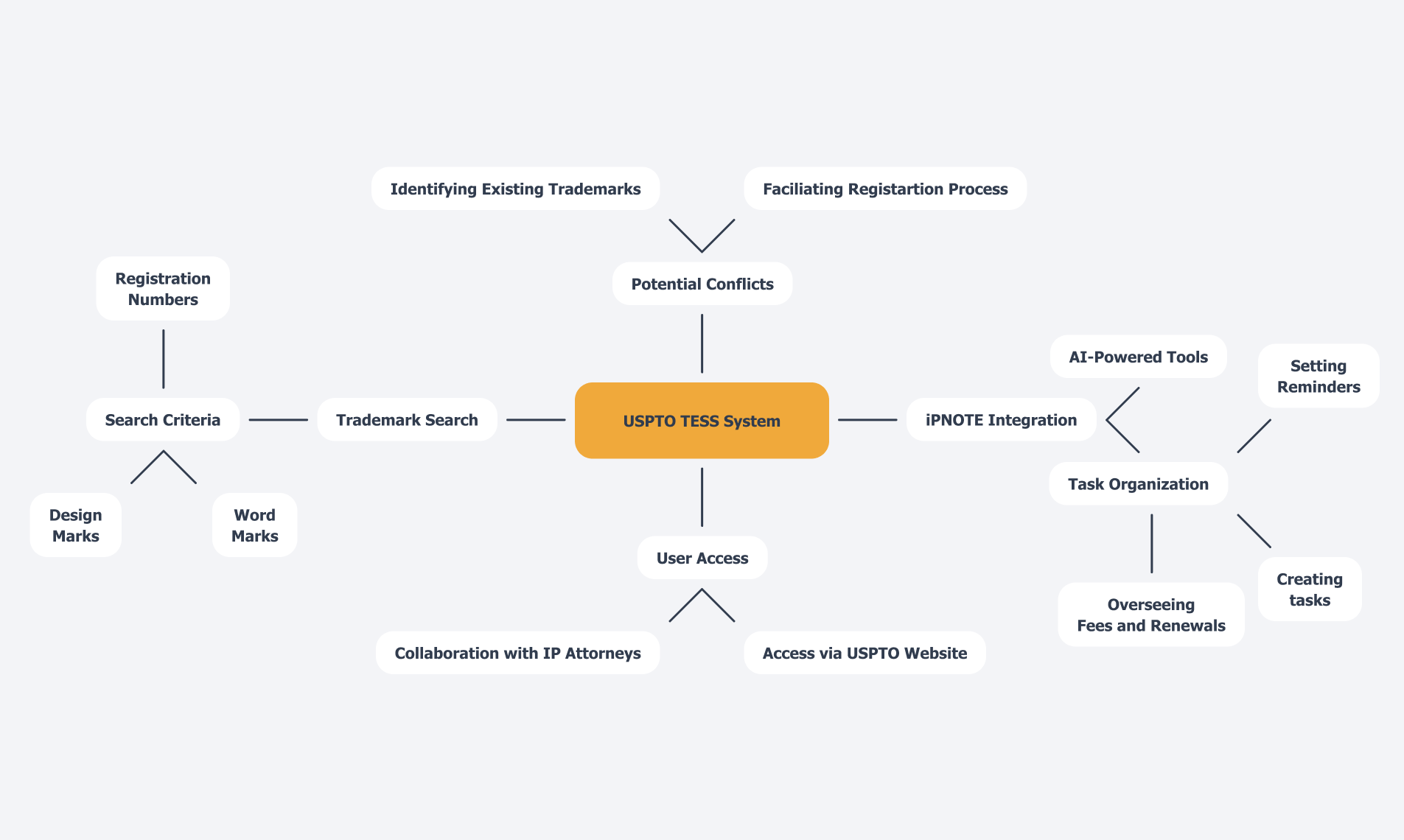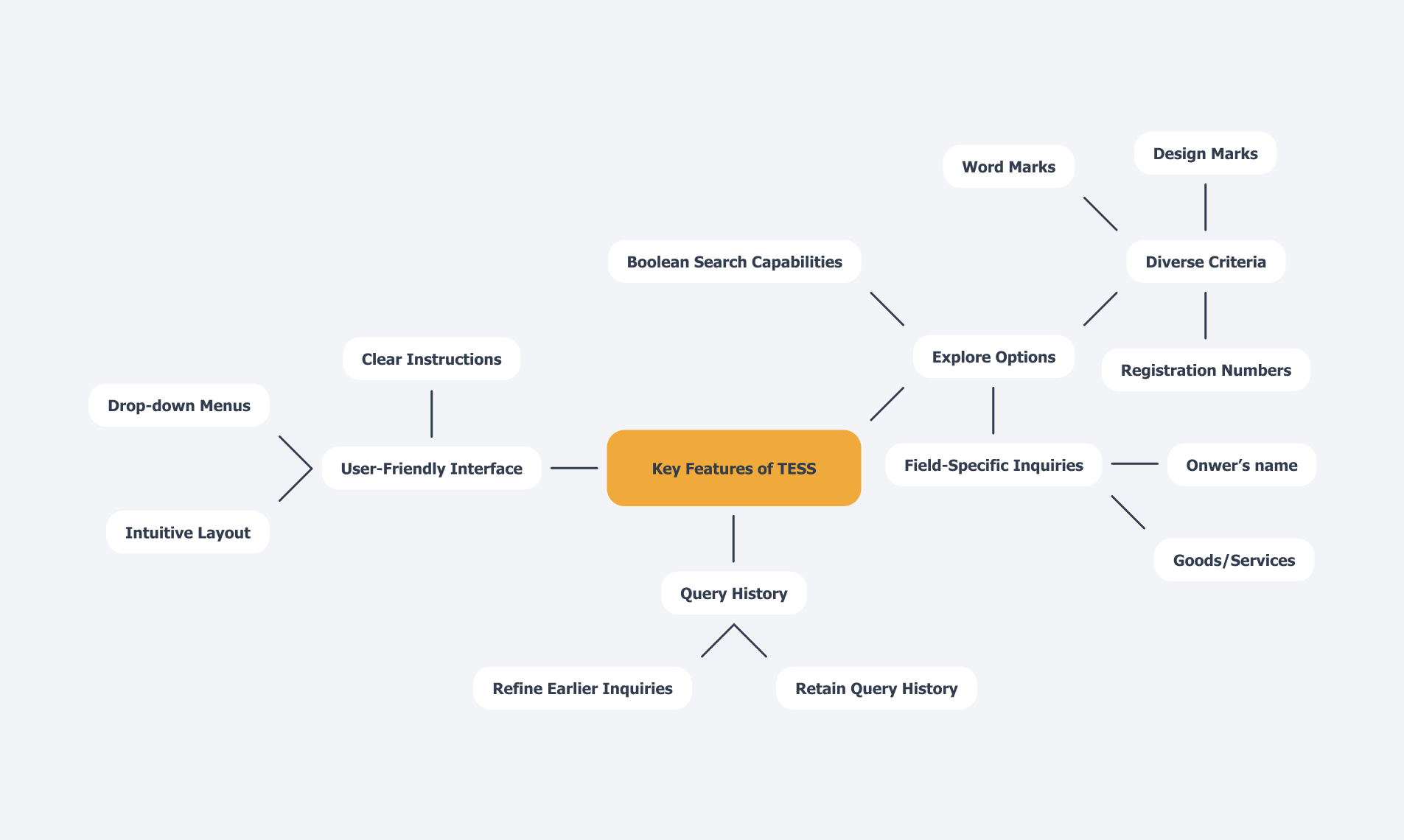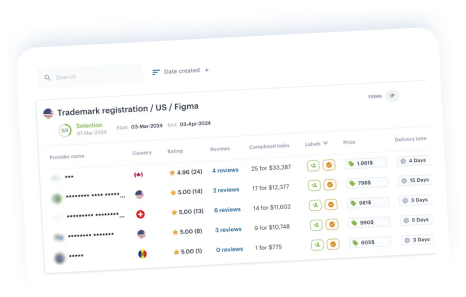Overview
Effective trademark searches using the USPTO TESS system are crucial for successful registrations. The essential steps include:
- Accessing the database
- Selecting the appropriate search type
- Entering relevant criteria
- Reviewing results
- Documenting findings
By diligently following these steps, along with employing best practices and being aware of potential challenges, you significantly enhance your chances of securing trademark registrations and avoiding conflicts with existing marks. Are you ready to take your trademark management to the next level? Understanding these processes is not just beneficial; it is essential for safeguarding your intellectual property.
Introduction
In the realm of intellectual property, navigating the complexities of trademark registration presents a significant challenge for businesses. The Trademark Electronic Search System (TESS), maintained by the United States Patent and Trademark Office (USPTO), is an indispensable tool for corporate IP managers aiming to secure their brand identities.
By enabling users to conduct thorough searches for existing trademarks and pending applications, TESS not only identifies potential conflicts but also streamlines the registration process. Furthermore, innovative solutions like iPNOTE enhance collaboration between IP attorneys and corporate managers, underscoring the necessity of effectively utilizing TESS to ensure successful trademark applications.
This article explores the key features of TESS, provides a step-by-step guide for conducting trademark searches, and discusses the challenges and best practices that can facilitate a smoother trademark management experience.
Overview of the USPTO TESS System
The USPTO TESS, or Trademark Electronic Search System, is a pivotal online database maintained by the United States Patent and Trademark Office (USPTO). It empowers users to search for existing trademarks and pending applications, a critical function for corporate IP managers intent on registering a trademark. By leveraging this system, users can identify potential conflicts with current symbols, thereby facilitating a more seamless registration process.
Moreover, iPNOTE amplifies this experience by offering AI-powered tools that enhance collaboration between IP attorneys and corporate managers. Users can access the trademark database via the USPTO website, conducting searches based on various criteria such as word marks, design marks, and registration numbers.
With the integrated services provided by iPNOTE, managing your brand application becomes significantly more efficient, aiding in the tracking of progress and communications related to your intellectual property. The digital assistant continuously analyzes your patent portfolio, setting reminders, creating tasks, and overseeing fees and renewals.
Understanding how to navigate USPTO TESS, along with utilizing iPNOTE’s resources for task organization and communication monitoring, is the essential first step toward ensuring that your brand application is successful and does not infringe upon existing marks.

Key Features and Functionalities of TESS
The powerful set of tools offered by USPTO TESS significantly enhances the brand inquiry process.
Explore Options: Users can conduct both fundamental and sophisticated inquiries utilizing diverse criteria, such as word marks, design marks, and registration numbers, ensuring comprehensive coverage of the brand landscape. The uspto tess system’s Boolean search capabilities support Boolean operators (AND, OR, NOT), allowing users to refine their inquiries for more precise results. Remarkably, around 60% of users leverage these features to improve their accuracy in queries, with numerous companies reporting enhanced outcomes in their brand investigations. Furthermore, uspto tess enables users to conduct Field-Specific Inquiries, allowing searches within specific fields, such as the owner’s name or the goods/services associated with the mark, thus facilitating focused investigations. The Query History feature enables users to retain their query history, making it convenient to revisit and refine earlier inquiries—an especially advantageous tool for ongoing brand monitoring. Lastly, the User-Friendly Interface, designed with user experience in mind, utilizes the uspto tess system, boasting an intuitive layout with drop-down menus and clear instructions that guide users effortlessly through the inquiry process. These functionalities not only simplify the inquiry experience but also enhance user satisfaction. Numerous intellectual property lawyers, including Sean D. Detweiler, have praised the system for its adaptability to the evolving needs of the branding community, highlighting its efficiency in meeting the demands of corporate IP managers.

Step-by-Step Guide to Conducting a Trademark Search
To effectively conduct a trademark search using the TESS database, follow these essential steps:
- To access USPTO TESS, you should first visit the USPTO website and navigate to the TESS page.
- Choose Your Query Type: Determine whether a Basic or Advanced inquiry suits your needs best.
- Enter Search Criteria: For a basic query, input the term you wish to check. For advanced searches, employ Boolean operators and field tags to refine your results further.
- Review Search Results: Analyze the displayed results meticulously, paying close attention to brands that are similar or identical to your proposed mark.
- Check Details: Click on individual marks to access detailed information, including their status, ownership, and associated goods/services.
- Preserve Your Discoveries: Document your results and pertinent information for future reference, aiding in the evaluation of your brand application’s viability.
In 2023, Class 9 (technology) emerged as the most popular category for brand registrations, accounting for 20% of total filings. This underscores the importance of comprehensive investigations in a rapidly evolving industry, as companies must ensure their identifiers are distinct to avert disputes. The typical expense of submitting a brand registration request was $275, which emphasizes the necessity of conducting a thorough inquiry before proceeding. As the USPTO advises, “If you eventually want to open multiple locations across the country, plan ahead and consider federal registration.” By adhering to these steps and leveraging the additional resources available in the help section, including USPTO TESS, you can significantly enhance your success rate in intellectual property applications. Many IP managers stress the importance of comprehensive searches in preventing potential conflicts.

Challenges and Best Practices in Trademark Searching
Trademark searching presents significant challenges for businesses navigating the complexities of intellectual property. Understanding these challenges and implementing best practices is essential for effective brand management.
Common Challenges:
- Similar Marks: The existence of numerous trademarks that may appear similar can lead to confusion. Variations in spelling, phonetics, and design elements must be meticulously considered to avert potential conflicts.
- Incomplete Queries: A prevalent issue arises when individuals conduct inquiries without employing thorough strategies, resulting in missed pertinent indicators. Data indicate that a substantial portion of brand applications face difficulties due to similar existing symbols, often stemming from insufficient inquiries. Studies reveal that nearly 30% of brand applications encounter issues related to similar marks due to inadequate search efforts.
- Database Limitations: The database limitations of USPTO TESS indicate that it, while comprehensive, does not encompass all marks, particularly those that are not federally registered. Your trademark will be listed in the USPTO’s online database; however, to mitigate this risk, consulting state databases is advisable.
Best Practices:
- Utilize Multiple Variations: Conduct searches using diverse spellings, synonyms, and related terms to ensure a thorough examination of potential conflicts. This strategy significantly diminishes the likelihood of overlooking similar marks.
- Document Everything: Maintaining detailed records of your inquiries and discoveries is crucial. This documentation serves as a valuable reference during the application process and can substantiate your claims if disputes arise.
- Consult Experts: Engaging an intellectual property attorney can provide invaluable insights and a more comprehensive search. Their expertise can aid in identifying potential disputes and effectively managing the intricacies of intellectual property law. Companies are advised to collaborate with intellectual property lawyers to ensure reliable and thorough brand clearances.
- Stay Updated: Regularly monitoring updates to the USPTO TESS database and changes in intellectual property laws is vital. Changes in regulations or new filings can impact your findings and overall strategy.
By addressing these challenges and adhering to best practices, companies can enhance their brand search processes, ultimately leading to more successful registrations and a reduced risk of infringement. Furthermore, grasping the distinctions between trademarks, copyrights, and patents is essential, as illustrated in the case study “Trademark vs. Copyright vs. Patent,” which elucidates the different legal implications of each form of intellectual property.

Conclusion
Navigating the complexities of trademark registration is a critical undertaking for businesses striving to protect their brand identities. The Trademark Electronic Search System (TESS) plays a pivotal role in this process, offering a comprehensive database that allows users to identify existing trademarks and pending applications. By utilizing TESS effectively, corporate IP managers can minimize potential conflicts and streamline their trademark applications, ensuring a smoother registration experience.
Key features of TESS, including advanced search options, Boolean capabilities, and field-specific inquiries, empower users to conduct thorough and precise searches. The user-friendly interface further enhances the search experience, making it accessible even for those less familiar with trademark law. Incorporating tools like iPNOTE can further optimize the trademark management process, allowing for efficient tracking of progress and communication between stakeholders.
Despite these advantages, challenges remain in trademark searching, such as the prevalence of similar marks and the limitations of the TESS database. To overcome these hurdles, businesses should adopt best practices, including:
- Utilizing multiple variations in searches
- Documenting findings meticulously
- Consulting with trademark professionals
Staying informed about updates in trademark laws and the TESS database is equally essential for maintaining an effective trademark strategy.
In conclusion, leveraging TESS alongside best practices not only enhances the likelihood of successful trademark registrations but also safeguards businesses against potential legal conflicts. A proactive approach in trademark searching and management is vital in today’s competitive landscape, where brand identity is a significant asset. Emphasizing the importance of thorough searches and strategic planning can lead to a more secure and resilient business presence in the marketplace.
Secure Your Brand with Smart Trademark Solutions.
Start now with iPNOTE and navigate trademark registration effortlessly.
Frequently Asked Questions
What is the USPTO TESS?
The USPTO TESS, or Trademark Electronic Search System, is an online database maintained by the United States Patent and Trademark Office (USPTO) that allows users to search for existing trademarks and pending applications.
Why is the USPTO TESS important for corporate IP managers?
It is critical for corporate IP managers because it helps them identify potential conflicts with current trademarks, facilitating a smoother trademark registration process.
How can users access the trademark database?
Users can access the trademark database via the USPTO website and conduct searches based on various criteria such as word marks, design marks, and registration numbers.
What role does iPNOTE play in trademark management?
iPNOTE enhances the trademark management experience by offering AI-powered tools that improve collaboration between IP attorneys and corporate managers, making the process more efficient.
What features does iPNOTE provide for managing brand applications?
iPNOTE provides integrated services that aid in tracking progress, managing communications related to intellectual property, analyzing patent portfolios, setting reminders, creating tasks, and overseeing fees and renewals.
What is the significance of understanding how to navigate USPTO TESS and utilize iPNOTE?
Understanding how to navigate USPTO TESS and utilize iPNOTE’s resources is essential for ensuring that a brand application is successful and does not infringe upon existing trademarks.






